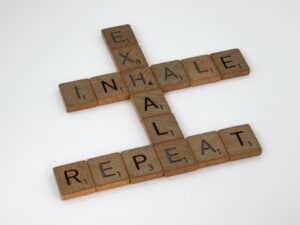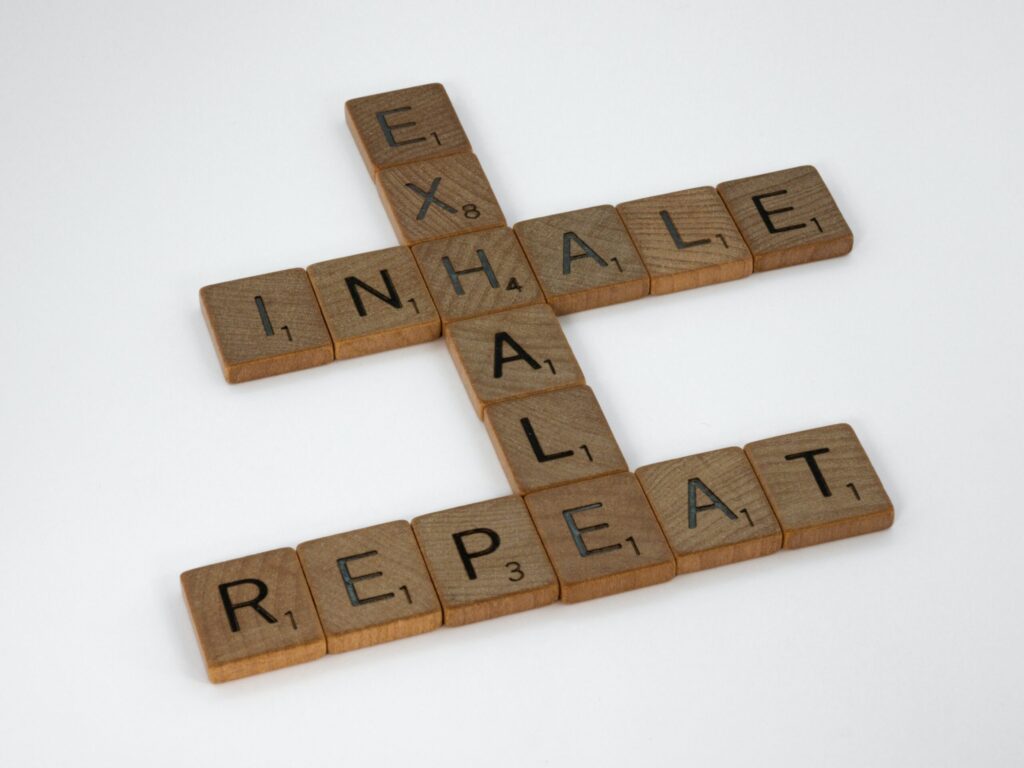
Ever noticed what happens to your breathing when your stressed out?
Breathing gets shallower and quicker. Each inhale takes more effort with even less benefit. The upper chest and shoulders pump with each breath. The shoulders then become so tight they glue themselves to the ears. The lower ribs and diaphragm seize up and stop pumping all together. Heart rate rises. Respiratory rate increases and pretty quickly we are gasping for air.
Not exactly pleasant, is it?
However, as much as breathing can be accelerated or changed by stress, breathing is also something we can consciously control. We can use breathing to relax our bodies to change our perception of stress and bring a sense of calm back into the picture.

So sit back, take a breath and today lets run through three of the best breath based practices you can do from the safety and comfort of your home to help combat stress and reduce some of the inherent anxiety it brings.
These first two techniques were introduced to me by the Huberman Lab podcast. If you’re looking for a science backed podcast designed to help you live your best life and make the most out of your workouts, diet, sleep or stress, check it out. Each episode is about 2hours long and is jam packed with delicious nerdy goodness which I’m loving.
The Physiological Sigh
Breathing a sigh of relief. Science says sighing is good for us, especially a physiological sigh. This physiological sigh is something you might have noticed we’ve been implementing at Transitions Chiropractic lately. It’s a super simple process that literally involves a double inhale followed by a single, slow deliberate exhale. Ideally repeat 10 times.
In the office, we’ve seen people change and calm down literally performing just one repetition of this breath. For those clients when lying down are so tense their shoulders seem fixed to their ears, a physiological sigh breaks down the resistance. When a client’s breath is at panic stations their body tells a tale. Their muscles are tight and tense and for some there’s almost no movement or expansion of their ribs either on the breath in or out.
On a nervous system level this is the autonomic nervous system living in full sympathetic dominance- the body is in overdrive! This is great when we are swimming from a shark. But it’s not a good place to be when the stressor is everyday life, the bombardment of emails, social media and COVID scares. Literally one physiological sigh or double breath in and one slow breath out has been enough to help some clients relax. By consciously slowing down the breath and increasing the exposure to oxygen we kick back on the parasympathetic or relaxation branch of the nervous system. Allowing calm to come back into the picture.
Next time you find yourself getting stressed out, or your breath is hitting panic stations try a physiological sigh. Better yet, try it with a child when they are in the midst of a temper tantrum especially if you can place a calming hand on their shoulder. I’ll bet you’ll notice that when you ask someone else to do this double inhale, slow exhale, you’ll mimic it too and soon you’ll be coherently breathing and relaxing together.
Non Sleep Deep Rest
Non Sleep Deep Rest (NSDR) or Yoga Nidra is the second technique introduced to me by the Huberman Lab. Some of the claims behind this are amazing, from helping you switch off at night, to enhancing learning and even helping you make up for lost sleep! Either way it sound good enough and simple enough to try. I’ve tried three different NSDR practices so far all in that 20- 35 minute range and I must say I’ve enjoyed them all.
They are quite an intense focused or meditative practice where you are guided to bring your attention to particular body parts, sounds going on around you and your own breath. The link for two different NSDR practices are below, the first is from Madefor and the second is courtesy of the Insight timer.
Madefor: https://www.youtube.com/watch?v=pL02HRFk2vo
Insight Timer: https://insighttimer.com/jenniferpiercy/guided-meditations/yoga-nidra-for-sleep
The Box Breath
The third and final practice today is the box breath. Perhaps the simplest of all the techniques because of the visual representation involved or through the rhythmic counting. With the box breath you consciously count as you inhale, exhale and on the pauses in between.
The most common protocol is to imagine that you are constructing a box with each breath. On the inhale you construct the side wall of the box and breathe in for a count of 4. Next, construct the roof of the box and hold for a count of 4. Then, exhale for 4 and construct the final side of the box. Finally, complete the bottom of the box and hold for 4. If the count of 4 is too long, shorten each “side of your box” to a count of 2. Once the box breath is complete, repeat the process.
Yes stress is real. When stress is present, the downward spiral seems to get quicker and quicker. Breathe. There is always something we can control. Breathing is one of the simplest and most powerful tools in our weaponry. Hopefully the three techniques above will help turn calamity into calm. From chaos we can find control.
“Breathe deeply, until sweet air extinguishes the burn of fear in your lungs and every breath is a beautiful refusal to become anything less than infinite.” – D. Antoinette Foy
______________________________________________________________________________
For more info please check out:
Physiological Sigh: https://scopeblog.stanford.edu/2020/10/07/how-stress-affects-your-brain-and-how-to-reverse-it/
Non Sleep Deep Rest: https://getmadefor.com/blogs/perspective/get-deep-rest-anytime-and-anywhere-with-this-free-tool
Box Breath: https://www.youtube.com/watch?v=FJJazKtH_9I

